22+ Job Analysis Examples to Download
A job analysis is a process of identifying and determining in specifics the particular job duties and requirements, and the relative importance of these said duties for a given job. Job analysis is a name you call a process wherein everyone makes judgments about the data collected on a job. It’s important to be sensitive about that one detail in job analysis: it doesn’t seek to focus on the person doing the job, it focuses on the job being conducted. Although a job analysis can only be done through a series of interviews and questionnaires, the product of the analysis will still be a description or a specification of the job, not of the person.
Job Analysis Form Template
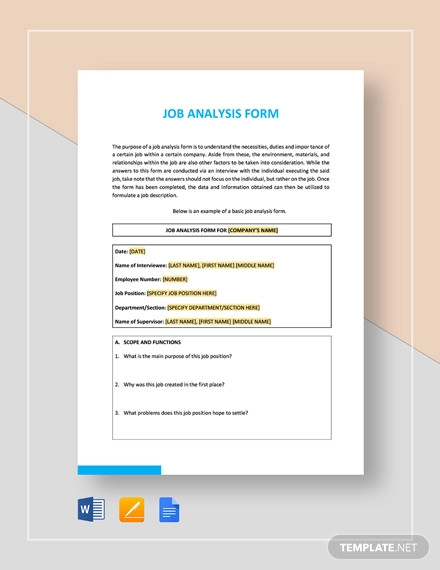
A job analysis will gather and analyze information about the content and the human requirements of a job, as well as the context in which the jobs are performed. You may also check out here earned value analysis examples & samples. It is used to determine the placement of jobs. A job analysis will define the organization of jobs within a job family.
Free Job Analysis Example
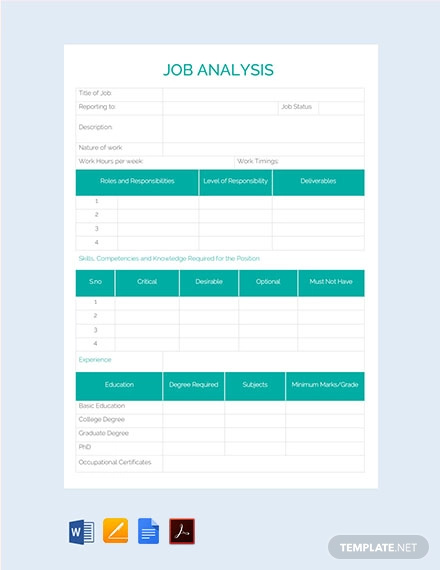
Job Analysis Gantt Chart Template
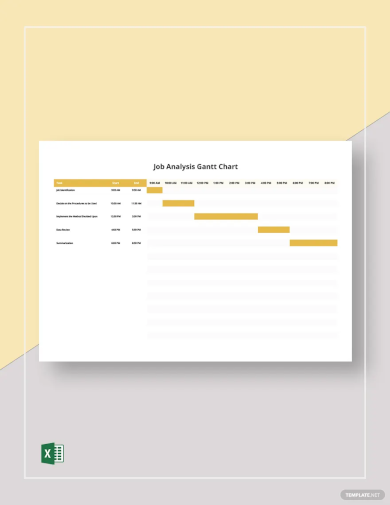
Job Analysis Report Template
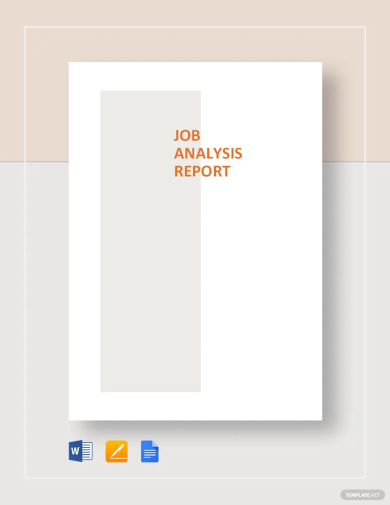
Job Safety Analysis Template

Source
Job Task Analysis Template
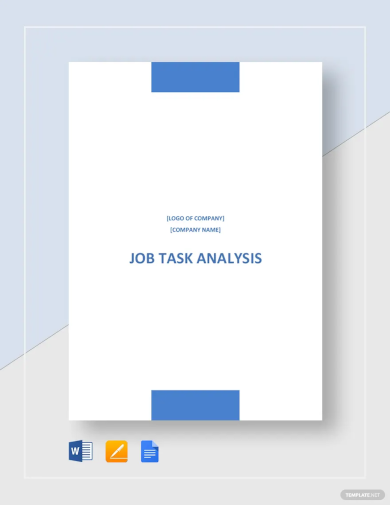
Job Safety Analysis Spreadsheet Template
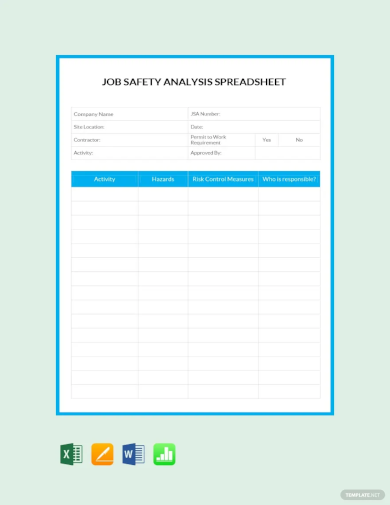
Job Hazard Analysis Template
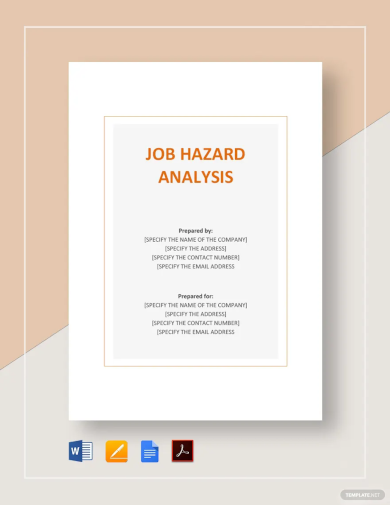
Financial Analysis Manager Job Description Template

Financial Planning and Analysis Manager Job Description Template

Business Analyst Job Description Template
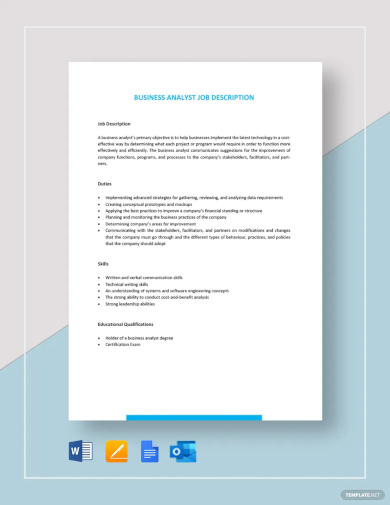
Job Analysis Form Template
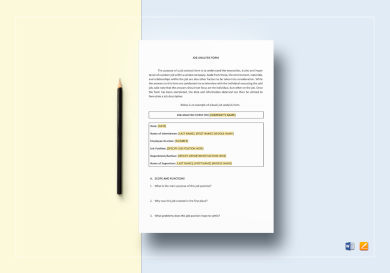
Job Analysis Report Template
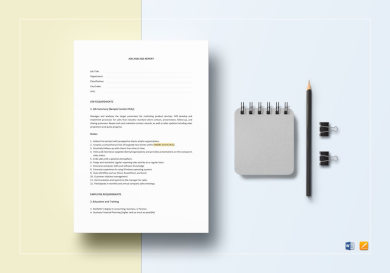
Job Analysis Document Example
Community Church Job Analysis Example
Things to Remember:
If you miss even one critical information, you could end up not paying an employee correctly, which can lead to employee discontent, or hiring someone who lacks an essential skill needed for performing the job. A job analysis will divide and slowly study each core function imperative for the success of the job. You may also see bowtie risk analysis examples. It is helpful in providing an overview of the fundamental requirements of any position in the company.
Furthermore, job analysis will provide
- a list of the competencies needed to be assessed,
- examples of behaviors that clarify the competencies,
- suggestions as to the types of exercises that resemble job situations,
- suggestions for problem content to be used in the exercises,
- an indication of the level of proficiency required for the competencies,
- standards for scoring applicant performance in the exercises, and
- documentation of job-relatedness of the assessment process (for use in the event of a lawsuit).
In summary, a job analysis is the most comprehensive way to understand the specific “can do” and “will do” components of a job. With its help, you will know to accurately identify job candidates with the highest potential to become high performers. By using a job analysis to build a solid talent selection foundation, you can open your organization to many benefits such as higher customer satisfaction, higher revenue per call, and improved company culture.
Accounting Clerk Job Analysis Example
Job Analysis Document Summary
The Purpose of Job Analysis
The main purpose of a job analysis is to establish and document the job relatedness of employment procedures in training, selection, compensation, and performance appraisal.
- Determining training needs: A job analysis can be used to analyze training content, assessment tests to measure the effectiveness of training, the equipment that will be used in delivering the training, and the methods of training (in small groups, computer-based, video, or classroom).
- Compensation: A job analysis will be used in compensation to identify or determine skill levels, compensable job factors, work environment (such as hazards, attention, and physical effort), responsibilities (such as fiscal or supervisory), and the required level of education (which is indirectly related to salary level).
- Performance review: A job analysis can be used in a performance review to identify or develop goals and objectives, performance standards, evaluation criteria, length of probationary periods, duties to be evaluated.
How to Perform a Job Analysis
There are certain steps that you need to follow to successfully create a job analysis. It includes the following:
1. Reviewing the job responsibilities of current employees.
This step is crucial for you to effectively proceed with the whole process. You must ask actual employees who are doing the job about what they do on the job daily. You might be tempted to ask the HR management or some other senior department for this part, but you’d be surprised at how clueless these people are about the day-to-day functions of the other job positions in the company. You may also see hazard analysis examples.
After all, we can’t expect them to be the expert in everything except in their jobs. They may see the external, big picture, but they are just as clueless as you are about what goes on in a job they are not handling. The only people who have an inkling about what the work actions and behavior go into the job are the employees who do them.
Once you’ve chosen the people who will be answering questions for you, make sure you make them understand the main purpose of the job analysis, and what exactly it is that you need them to do. Ask them to be thorough with the answers they provide, otherwise, the data you gather for the analysis will not be useful or effective. You may also see failure analysis examples.
If they start saying job descriptions like “produce monthly reports,” cut them short and ask them exactly what types of reports they make, what technicalities are involved in the job, and what information they need to complete it. Delve deep into the answer given to you until you understand exactly what the employees of that particular job position are dealing with.
Imagine this: if an employee only talks about the superficial parts of his job, you may be inclined to think that whatever it is he does is easy and manageable enough that you start lowering your standards for that position. An applicant comes in, tries to apply, and you hire him without much thinking since you’ve embraced the idea that the job is a no-brainer, not knowing that you simply didn’t take all the information about it. Now, you have an incapable employee in your hands and a job that is far from being done. You may also see business systems analysis examples.
This is the risk that comes with a job analysis that has been poorly executed. So make sure that you explain it well to your employee, and ask him to describe his daily duties sufficiently. Enough knowledge about it will give your company the right standards by which to judge and inspect the applicants for that position. You will only be able to hire the next qualified employee who has the real talent to do the job.
2. Doing internet research and viewing sample job descriptions online or offline.
Although we will never want to copy another company’s job descriptions, looking at a few of them will help write your own. Of course, even if you and a neighboring company are both in the same industry, and need the same qualifications in employees, it doesn’t necessarily mean that you have the same job descriptions or standards. You need to write it yourself, with only your company and its needs in mind. You may also see vendor analysis examples.
However, for inspiration, you can find sample job descriptions by searching for “[Job Title] Sample Description” or you can look at job postings for positions companies are currently hiring. You can even reference LinkedIn to study how people describe their accomplishments in a job. This is done to give you an idea of how to phrase your sentences in a way that will be potent for your aim. It can also help make sure that you don’t forget about the tasks and responsibilities you may neglect to include.
3. Analyzing the work, duties, tasks, and responsibilities needed by an applicant for the job.
By doing this, you may discover that not every job in the company is optimized. You may find that some duties are undone and that some projects will do better if moved from one department to another. You may discover that there are some tasks that another job will be able to perform and achieve better, more flattering results. You may also see training needs analysis examples.
When you’re doing a job analysis, make sure that you look at the needs of the company—always—and at any unassigned or illogical responsibility. Then, start working with the management to add the proper tasks to the proper job analysis. This way, you will be achieving more with your time.
4. Researching and sharing with other companies that have similar jobs.
Companies aren’t always competitors. Sometimes, they’d even be happy to share information about their job descriptions, or even compare your salaries with one another. These types of neighbors will be able to help you figure out what to include in your job description.
5. Articulate the most important outcomes or contributions needed from the position.
Sometimes, we focus too much on the responsibilities that the job entails that we forget to discuss the results we want to achieve from it. Of course, your employees aren’t only working because it’s their job. They are working because they are trying to aim for a result, a product. This is the reason why they have been hired by the company: because they are a means to an end. You may also see product gap analysis examples.
The more information you can gather, the easier it will be for you to write the actual job description. There’s no need to worry about pretty language. Nobody is looking for a poet around here. You want a functional job description more than anything else. Make sure that it is clear and concise. To help you judge your writing, ask yourself the question “If somebody else read this, would they know what the person in this position does?” If you find yourself answering yes to that, then you’ve done a great job. Otherwise, there’s still work for you to do.
Legal Assistant Job Analysis Example
Administrative Accounting Job Analysis Example
Job Analysis Formal Document
Job Analysis of a CEO
Job Analysis Methods
Determining the tasks that each employee performs is not easy. The observer’s perception usually influences direct observation, and this subjectivity can only have a terrible effect on the results of the analysis. The most effective technique, therefore, is to collect information directly from the most qualified incumbents using two preferable methods: direct observation and a structured questionnaire. The following describes the most common job analysis methods:
- Open-ended questionnaire: Job incumbents and sometimes their managers fill out questionnaires necessary for the job. The HR department will compile the answers and publishes a composite statement of job requirements. This method will help produce reasonable job requirements with input from employees and managers and helps analyze many jobs with limited resources. You may also see situation analysis examples.
- Highly structured questionnaire: These questionnaires will only allow specific responses that are aimed at determining the frequency with which specific tasks are performed, their importance, and the skills they require. The structured questionnaire will also help define a job objectively, which can be useful when analyzing with computer models.
- Interview: A face-to-face interview is also a great way for the interviewer to obtain the necessary information he needs from the employee. He will be using predetermined questions with additional follow-up questions based on the employee’s response. This method will work best for professional jobs.
- Observation: Employees are directly being observed performing their job tasks, although not always consciously. Observation proves itself a realistic view of the job’s daily tasks and activities and works best for short-cycle production jobs.
- Work diary or log: A work diary or log is an anecdotal record that the employee can maintain. It will include the frequency and timing of tasks. He can keep it for an extended period to make sure that enough data is gathered on the subject. The HR department will analyze the logs, identify the patterns so that he can translate them into duties and responsibilities. This method can provide an enormous amount of data. Unfortunately, much of it is difficult to interpret, not job-related, and difficult to keep up-to-date.
Printable Job Analysis Template
Job Task Analysis Example
Conclusion
Now that you know what a job analysis is and how it can be performed in a company, make sure that you do. It will help open up new opportunities for your company in terms of employee talents and manpower. They are, after all, your greatest resources.
One can never have enough good supply of them. You may also see cost analysis examples. With the help of the templates that are mentioned in this article, you can make the best analysis you need for your job. Try it out now!
General FAQs
1. What is a Job Analysis?
A job analysis can be defined as a procedure to identify the content of a job in terms of its activities involved and its attributes. It shows the job requirements needed to perform activities. Job analysis provides information on organizations that helps to determine which applicant/employee is the best fit for specific jobs.
2. Why is Job Analysis important?
It is a process used to collect information about the duties, skills, outcomes, etc. of a particular job. It helps in recruitment and selection, job evaluation, job designing, deciding salaries and compensation, benefits packages, performance appraisal, etc. Most importantly, it assesses the worth of a job and increasing personnel and organizational productivity.
3. What are the benefits of using a Job Analysis?
The benefits of using a job analysis are as follows:
- Helps managers determine the appropriate compensation package
- Analyze and decide on benefits and allowances for a job
- Helps in distributing responsibilities
- Informs about the hazards involved in a job
- It makes others aware of where the company stands in the market.
4. Why is a Job Analysis used?
A job analysis aims to study the processes, simplify the methods and establishing time standards for doing work. It also provides information regarding compensation and other benefits, hence improving personnel activities like recruitment, selection, training, etc. This way, you understand where you stand and what you can do to make your company better.
5. What are the components of a Job Analysis?
The following are the components of job analysis:
- Title of the analysis
- Job summary and description of each job available
- Tasks and responsibilities of the employees and other working in the organization
- Qualifications and skills required
- Working conditions of the company
- Salary, benefits and other incentives.
22+ Job Analysis Examples to Download
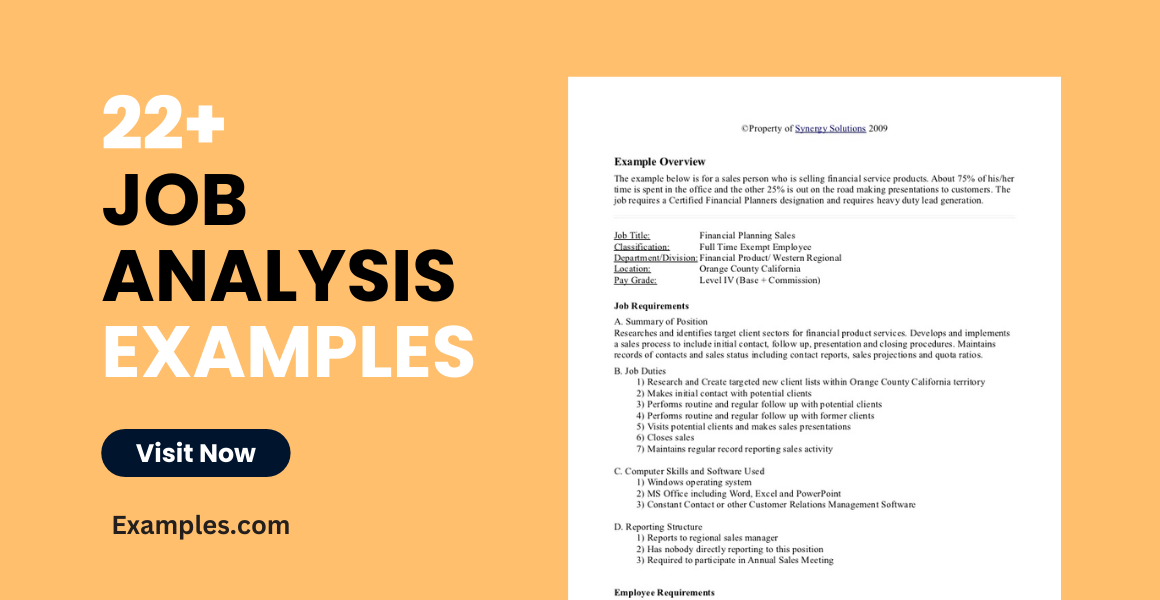
A job analysis is a process of identifying and determining in specifics the particular job duties and requirements, and the relative importance of these said duties for a given job. Job analysis is a name you call a process wherein everyone makes judgments about the data collected on a job. It’s important to be sensitive about that one detail in job analysis: it doesn’t seek to focus on the person doing the job, it focuses on the job being conducted. Although a job analysis can only be done through a series of interviews and questionnaires, the product of the analysis will still be a description or a specification of the job, not of the person.
Job Analysis Form Template

Details
File Format
Google Docs
MS Word
Pages
Editable PDF
Size: US, A4
A job analysis will gather and analyze information about the content and the human requirements of a job, as well as the context in which the jobs are performed. You may also check out here earned value analysis examples & samples. It is used to determine the placement of jobs. A job analysis will define the organization of jobs within a job family.
Free Job Analysis Example

Details
File Format
MS Word
Pages
Editable PDF
Size: A4, US
Job Analysis Gantt Chart Template

Details
File Format
Excel
Size: 28 KB
Job Analysis Report Template

Details
File Format
MS Word
Google Docs
Apple Pages
PDF
Size: 29 KB
Job Safety Analysis Template

Source
Details
File Format
MS Word
Google Docs
Apple Pages
PDF
Size: 26 KB
Job Task Analysis Template

Details
File Format
MS Word
Google Docs
Apple Pages
PDF
Size: 30 KB
Job Safety Analysis Spreadsheet Template

Details
File Format
Excel
MS Word
Apple Numbers
Apple Pages
Size: 33 KB
Job Hazard Analysis Template

Details
File Format
MS Word
Google Docs
Apple Pages
PDF
Size: 52 KB
Financial Analysis Manager Job Description Template

Details
File Format
MS Word
Google Docs
Apple Pages
PDF
Size: 66 KB
Financial Planning and Analysis Manager Job Description Template

Details
File Format
MS Word
Google Docs
Apple Pages
PDF
Size: 62 KB
Business Analyst Job Description Template

Details
File Format
MS Word
Google Docs
Apple Pages
PDF
Size: 66 KB
Job Analysis Form Template

Details
File Format
MS Word
Pages
Size: US, A4
Job Analysis Report Template

Details
File Format
MS Word
Pages
Size: US, A4
Job Analysis Document Example
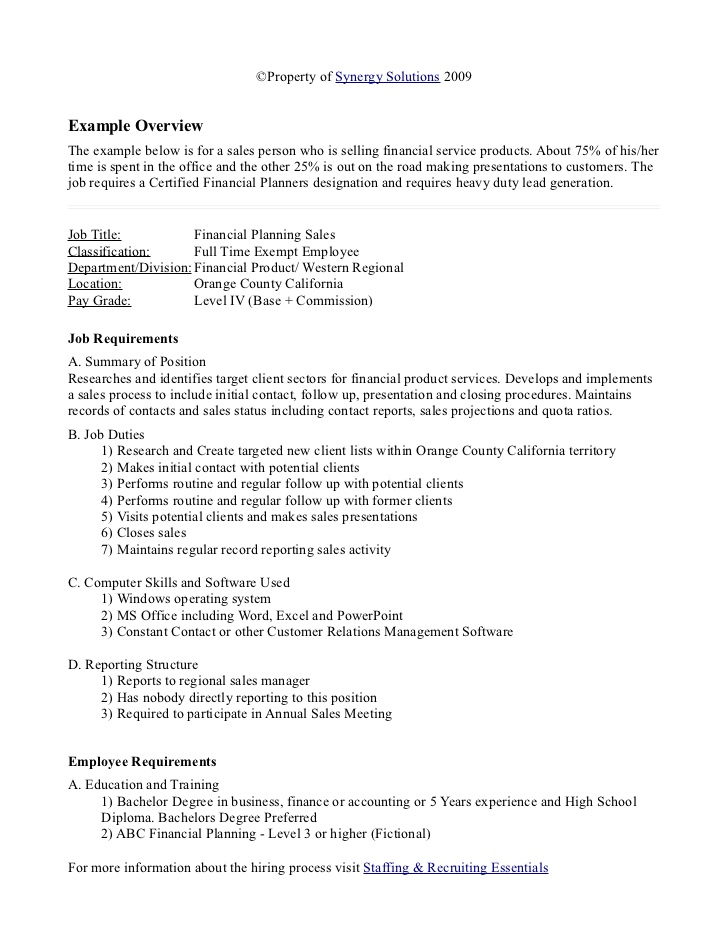
slideshare.net
Details
File Format
PDF
Size: 102 KB
Community Church Job Analysis Example
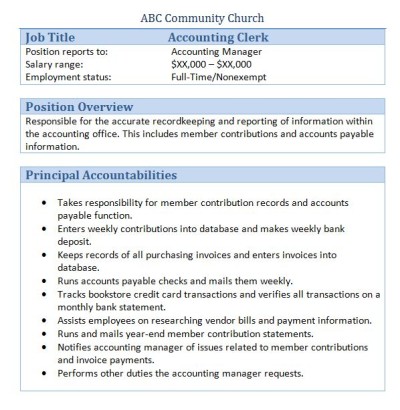
samplebusinessresume.com
Details
File Format
PDF
Size: 41 KB
Things to Remember:
If you miss even one critical information, you could end up not paying an employee correctly, which can lead to employee discontent, or hiring someone who lacks an essential skill needed for performing the job. A job analysis will divide and slowly study each core function imperative for the success of the job. You may also see bowtie risk analysis examples. It is helpful in providing an overview of the fundamental requirements of any position in the company.
Furthermore, job analysis will provide
a list of the competencies needed to be assessed,
examples of behaviors that clarify the competencies,
suggestions as to the types of exercises that resemble job situations,
suggestions for problem content to be used in the exercises,
an indication of the level of proficiency required for the competencies,
standards for scoring applicant performance in the exercises, and
documentation of job-relatedness of the assessment process (for use in the event of a lawsuit).
In summary, a job analysis is the most comprehensive way to understand the specific “can do” and “will do” components of a job. With its help, you will know to accurately identify job candidates with the highest potential to become high performers. By using a job analysis to build a solid talent selection foundation, you can open your organization to many benefits such as higher customer satisfaction, higher revenue per call, and improved company culture.
Accounting Clerk Job Analysis Example
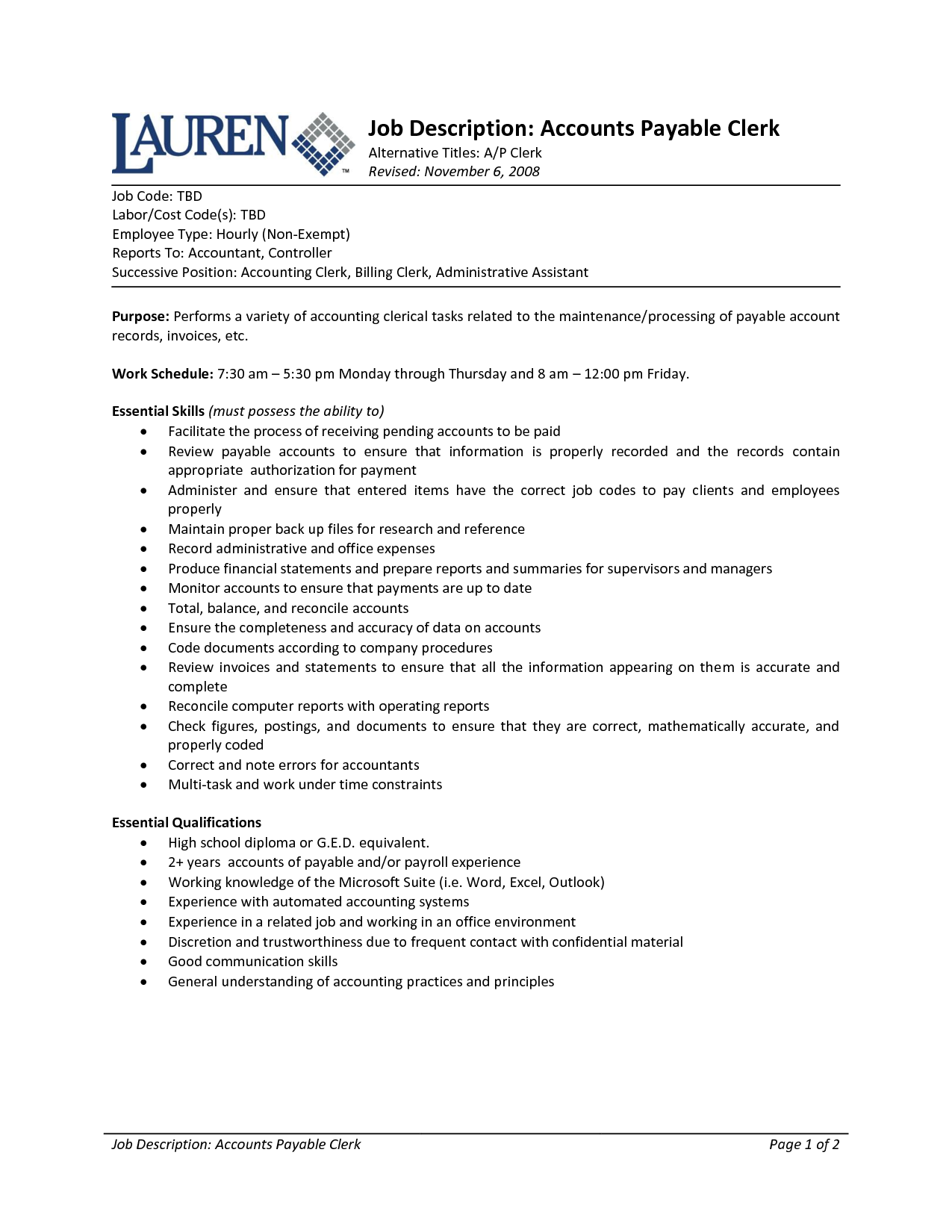
samplebusinessresume.com
Details
File Format
PDF
Size: 142 KB
Job Analysis Document Summary
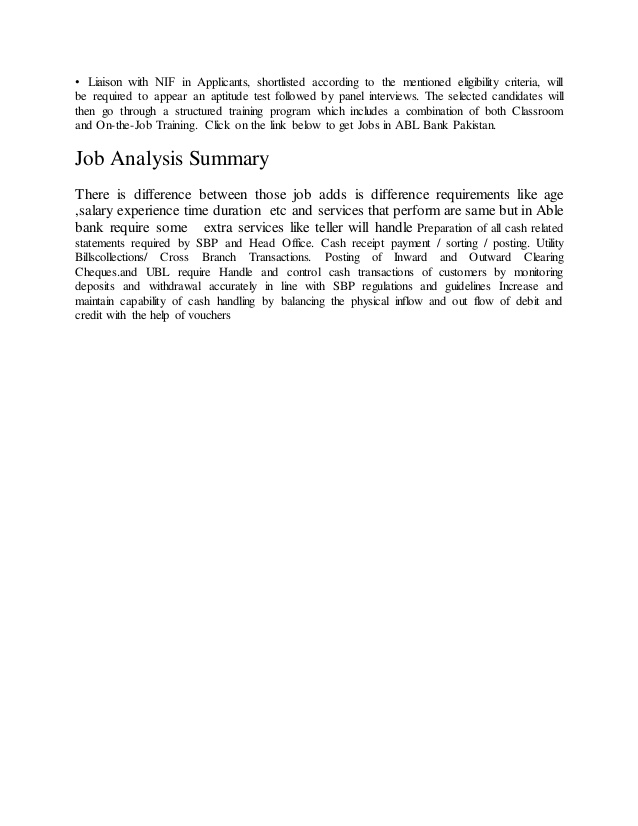
slideshare.net
Details
File Format
PDF
Size: 55 KB
The Purpose of Job Analysis
The main purpose of a job analysis is to establish and document the job relatedness of employment procedures in training, selection, compensation, and performance appraisal.
Determining training needs: A job analysis can be used to analyze training content, assessment tests to measure the effectiveness of training, the equipment that will be used in delivering the training, and the methods of training (in small groups, computer-based, video, or classroom).
Compensation: A job analysis will be used in compensation to identify or determine skill levels, compensable job factors, work environment (such as hazards, attention, and physical effort), responsibilities (such as fiscal or supervisory), and the required level of education (which is indirectly related to salary level).
Performance review: A job analysis can be used in a performance review to identify or develop goals and objectives, performance standards, evaluation criteria, length of probationary periods, duties to be evaluated.
How to Perform a Job Analysis
There are certain steps that you need to follow to successfully create a job analysis. It includes the following:
1. Reviewing the job responsibilities of current employees.
This step is crucial for you to effectively proceed with the whole process. You must ask actual employees who are doing the job about what they do on the job daily. You might be tempted to ask the HR management or some other senior department for this part, but you’d be surprised at how clueless these people are about the day-to-day functions of the other job positions in the company. You may also see hazard analysis examples.
After all, we can’t expect them to be the expert in everything except in their jobs. They may see the external, big picture, but they are just as clueless as you are about what goes on in a job they are not handling. The only people who have an inkling about what the work actions and behavior go into the job are the employees who do them.
Once you’ve chosen the people who will be answering questions for you, make sure you make them understand the main purpose of the job analysis, and what exactly it is that you need them to do. Ask them to be thorough with the answers they provide, otherwise, the data you gather for the analysis will not be useful or effective. You may also see failure analysis examples.
If they start saying job descriptions like “produce monthly reports,” cut them short and ask them exactly what types of reports they make, what technicalities are involved in the job, and what information they need to complete it. Delve deep into the answer given to you until you understand exactly what the employees of that particular job position are dealing with.
Imagine this: if an employee only talks about the superficial parts of his job, you may be inclined to think that whatever it is he does is easy and manageable enough that you start lowering your standards for that position. An applicant comes in, tries to apply, and you hire him without much thinking since you’ve embraced the idea that the job is a no-brainer, not knowing that you simply didn’t take all the information about it. Now, you have an incapable employee in your hands and a job that is far from being done. You may also see business systems analysis examples.
This is the risk that comes with a job analysis that has been poorly executed. So make sure that you explain it well to your employee, and ask him to describe his daily duties sufficiently. Enough knowledge about it will give your company the right standards by which to judge and inspect the applicants for that position. You will only be able to hire the next qualified employee who has the real talent to do the job.
2. Doing internet research and viewing sample job descriptions online or offline.
Although we will never want to copy another company’s job descriptions, looking at a few of them will help write your own. Of course, even if you and a neighboring company are both in the same industry, and need the same qualifications in employees, it doesn’t necessarily mean that you have the same job descriptions or standards. You need to write it yourself, with only your company and its needs in mind. You may also see vendor analysis examples.
However, for inspiration, you can find sample job descriptions by searching for “[Job Title] Sample Description” or you can look at job postings for positions companies are currently hiring. You can even reference LinkedIn to study how people describe their accomplishments in a job. This is done to give you an idea of how to phrase your sentences in a way that will be potent for your aim. It can also help make sure that you don’t forget about the tasks and responsibilities you may neglect to include.
3. Analyzing the work, duties, tasks, and responsibilities needed by an applicant for the job.
By doing this, you may discover that not every job in the company is optimized. You may find that some duties are undone and that some projects will do better if moved from one department to another. You may discover that there are some tasks that another job will be able to perform and achieve better, more flattering results. You may also see training needs analysis examples.
When you’re doing a job analysis, make sure that you look at the needs of the company—always—and at any unassigned or illogical responsibility. Then, start working with the management to add the proper tasks to the proper job analysis. This way, you will be achieving more with your time.
4. Researching and sharing with other companies that have similar jobs.
Companies aren’t always competitors. Sometimes, they’d even be happy to share information about their job descriptions, or even compare your salaries with one another. These types of neighbors will be able to help you figure out what to include in your job description.
5. Articulate the most important outcomes or contributions needed from the position.
Sometimes, we focus too much on the responsibilities that the job entails that we forget to discuss the results we want to achieve from it. Of course, your employees aren’t only working because it’s their job. They are working because they are trying to aim for a result, a product. This is the reason why they have been hired by the company: because they are a means to an end. You may also see product gap analysis examples.
The more information you can gather, the easier it will be for you to write the actual job description. There’s no need to worry about pretty language. Nobody is looking for a poet around here. You want a functional job description more than anything else. Make sure that it is clear and concise. To help you judge your writing, ask yourself the question “If somebody else read this, would they know what the person in this position does?” If you find yourself answering yes to that, then you’ve done a great job. Otherwise, there’s still work for you to do.
Legal Assistant Job Analysis Example
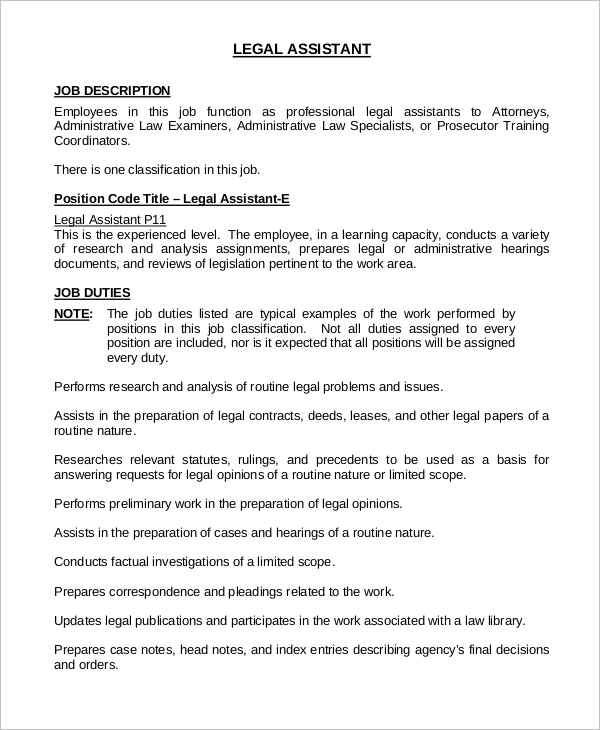
rockyrama.info
Details
File Format
PDF
Size: 90 KB
Administrative Accounting Job Analysis Example
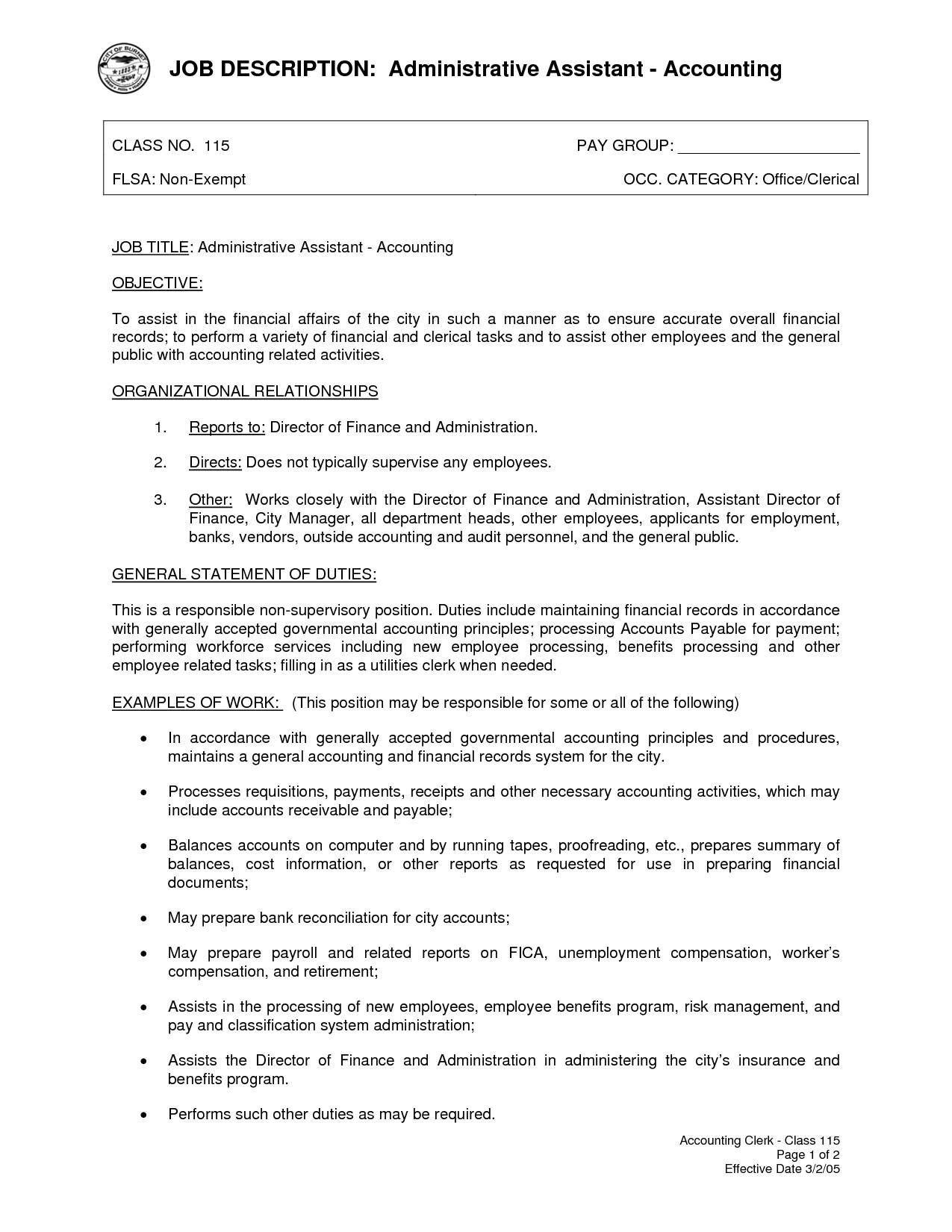
rockyrama.info
Details
File Format
PDF
Size: 514 KB
Job Analysis Formal Document
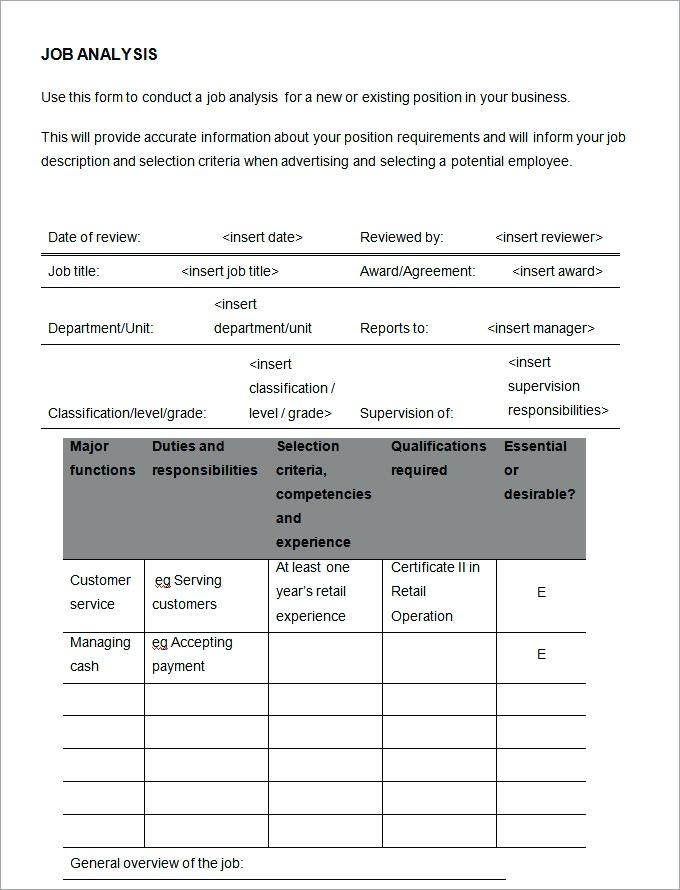
esdcuba.co
Details
File Format
PDF
Size: 89 KB
Job Analysis of a CEO

slideshare.net
Details
File Format
PDF
Size: 112 KB
Job Analysis Methods
Determining the tasks that each employee performs is not easy. The observer’s perception usually influences direct observation, and this subjectivity can only have a terrible effect on the results of the analysis. The most effective technique, therefore, is to collect information directly from the most qualified incumbents using two preferable methods: direct observation and a structured questionnaire. The following describes the most common job analysis methods:
Open-ended questionnaire: Job incumbents and sometimes their managers fill out questionnaires necessary for the job. The HR department will compile the answers and publishes a composite statement of job requirements. This method will help produce reasonable job requirements with input from employees and managers and helps analyze many jobs with limited resources. You may also see situation analysis examples.
Highly structured questionnaire: These questionnaires will only allow specific responses that are aimed at determining the frequency with which specific tasks are performed, their importance, and the skills they require. The structured questionnaire will also help define a job objectively, which can be useful when analyzing with computer models.
Interview: A face-to-face interview is also a great way for the interviewer to obtain the necessary information he needs from the employee. He will be using predetermined questions with additional follow-up questions based on the employee’s response. This method will work best for professional jobs.
Observation: Employees are directly being observed performing their job tasks, although not always consciously. Observation proves itself a realistic view of the job’s daily tasks and activities and works best for short-cycle production jobs.
Work diary or log: A work diary or log is an anecdotal record that the employee can maintain. It will include the frequency and timing of tasks. He can keep it for an extended period to make sure that enough data is gathered on the subject. The HR department will analyze the logs, identify the patterns so that he can translate them into duties and responsibilities. This method can provide an enormous amount of data. Unfortunately, much of it is difficult to interpret, not job-related, and difficult to keep up-to-date.
Printable Job Analysis Template
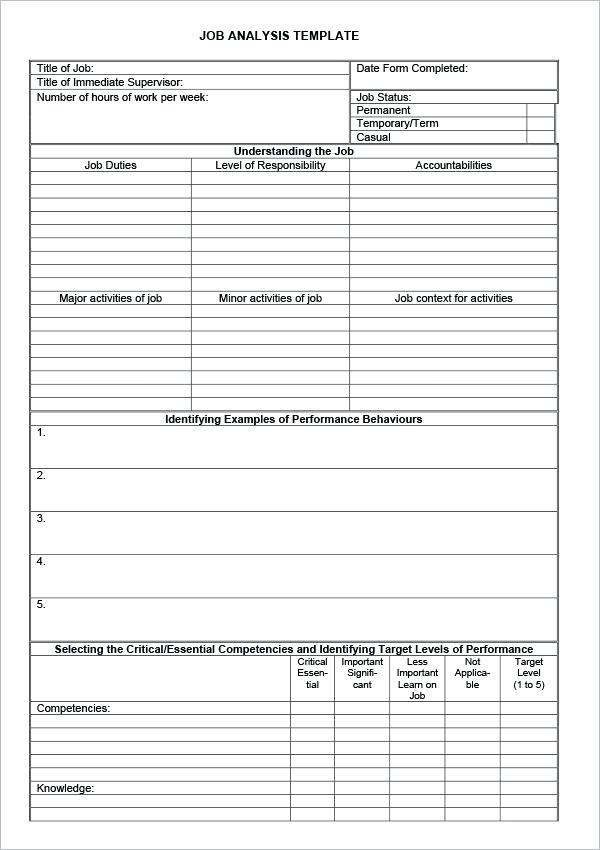
wellmake.co
Details
File Format
PDF
Size: 81 KB
Job Task Analysis Example

wellmake.co
Details
File Format
PDF
Size: 0 KB
Conclusion
Now that you know what a job analysis is and how it can be performed in a company, make sure that you do. It will help open up new opportunities for your company in terms of employee talents and manpower. They are, after all, your greatest resources.
One can never have enough good supply of them. You may also see cost analysis examples. With the help of the templates that are mentioned in this article, you can make the best analysis you need for your job. Try it out now!
General FAQs
1. What is a Job Analysis?
A job analysis can be defined as a procedure to identify the content of a job in terms of its activities involved and its attributes. It shows the job requirements needed to perform activities. Job analysis provides information on organizations that helps to determine which applicant/employee is the best fit for specific jobs.
2. Why is Job Analysis important?
It is a process used to collect information about the duties, skills, outcomes, etc. of a particular job. It helps in recruitment and selection, job evaluation, job designing, deciding salaries and compensation, benefits packages, performance appraisal, etc. Most importantly, it assesses the worth of a job and increasing personnel and organizational productivity.
3. What are the benefits of using a Job Analysis?
The benefits of using a job analysis are as follows:
Helps managers determine the appropriate compensation package
Analyze and decide on benefits and allowances for a job
Helps in distributing responsibilities
Informs about the hazards involved in a job
It makes others aware of where the company stands in the market.
4. Why is a Job Analysis used?
A job analysis aims to study the processes, simplify the methods and establishing time standards for doing work. It also provides information regarding compensation and other benefits, hence improving personnel activities like recruitment, selection, training, etc. This way, you understand where you stand and what you can do to make your company better.
5. What are the components of a Job Analysis?
The following are the components of job analysis:
Title of the analysis
Job summary and description of each job available
Tasks and responsibilities of the employees and other working in the organization
Qualifications and skills required
Working conditions of the company
Salary, benefits and other incentives.

